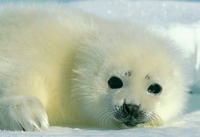Login form
Arctic

Ice and snow cover the Arctic for most of the year. Winter temperatures drop as low as -90° Fahrenheit (-68° Celsius). On land there are no trees. Only bushes, mosses, and flowers grow in the thin soil. Strangest of all, in the Arctic the Sun doesn’t rise for part of the year!
ARCTIC CIRCLE
Mapmakers like to draw an imaginary line around the top of the globe of Earth. That line is the Arctic Circle. The large region inside the line consists of the Arctic Ocean, many islands, and parts of Asia, Europe, and North America. Outside the circle, the Sun rises and sets every day. That’s not always the case inside the circle.
Winter days are frigid and dark in the Arctic. For weeks, the Sun barely peeks above the horizon. Then it doesn’t rise at all. That’s because Earth is tilted so that the Arctic stays mostly in shadow during winter.
In the southernmost parts of the Arctic, there is only one day when the Sun does not rise. That day is usually December 21. Farther north the Sun doesn’t rise for weeks on end!
The opposite is true in summer. Summer days in the Arctic are cool but bright. The Sun shines almost around the clock. In the southernmost parts of the Arctic the Sun never sets on one day, usually June 21. Farther north the Sun shines all summer!
ARCTIC OCEAN
The surface of the Arctic Ocean is frozen over much of the year. The ice can be 30 feet (9 meters) thick. During the short summers it only partially thaws. Holes in the ice open up, but the ocean ice never completely melts.
The Arctic Ocean is the smallest of the world’s four oceans. The North Pole lies in the middle of the Arctic Ocean.
THE NORTH POLE
You can’t get any farther north than the North Pole. Earth spins around its axis once each day. The axis is another imaginary line that passes through the planet. If you spin a basketball on your finger, the ball’s axis is the line pointing up from your finger through the middle of the ball. The North Pole is one end of Earth’s axis, and the South Pole is the other end.
Admiral Robert E. Peary, an American explorer, was the first person to reach the North Pole. He and five companions reached the pole on April 6, 1909.
DOES ANYONE LIVE IN THE ARCTIC?
People have lived in the Arctic for thousands of years. The Inuit people, who are often called Eskimos, live in northern Alaska and northern Canada. They are believed to be the descendants of people who came from Asia thousands of years ago. Some Inuit once lived in ice houses, or igloos, during winters, and hunted seals, walrus, and polar bears.
Parts of the United States, Canada, Greenland, Norway, Sweden, Denmark, and Russia are in the Arctic. Several large cities lie in the southern portion of the Arctic.
WILDLIFE
You might think the cold would keep animals away, but the Arctic has a lot of wildlife. The world’s biggest bear, the polar bear, lives there. These huge white bears are the only bears that spend a lot of time in the water.
Walruses, whales, seals, and fish live in the Arctic Ocean. Seals are a favorite food of polar bears.
A large number of animals live on land in the Arctic. Among them are foxes, wolves, and reindeer.
Birds flock to the Arctic in spring and summer. Ravens, snowy owls, gulls, and ducks are some of the more familiar ones. Many of the birds flee before the harsh winter sets in. They fly south to warmer lands. This flying back and forth in different seasons is called migrating. Some birds migrate as far south as Mexico and Central America.
Insects such as bees, mosquitoes, and butterflies live in the Arctic, too. Woolly bear caterpillars have an advantage over the other Arctic insects. Woolly bear caterpillars don’t die when they freeze. They can be frozen solid all winter and still crawl away when they thaw out in spring!
Source: Microsoft ® Encarta

